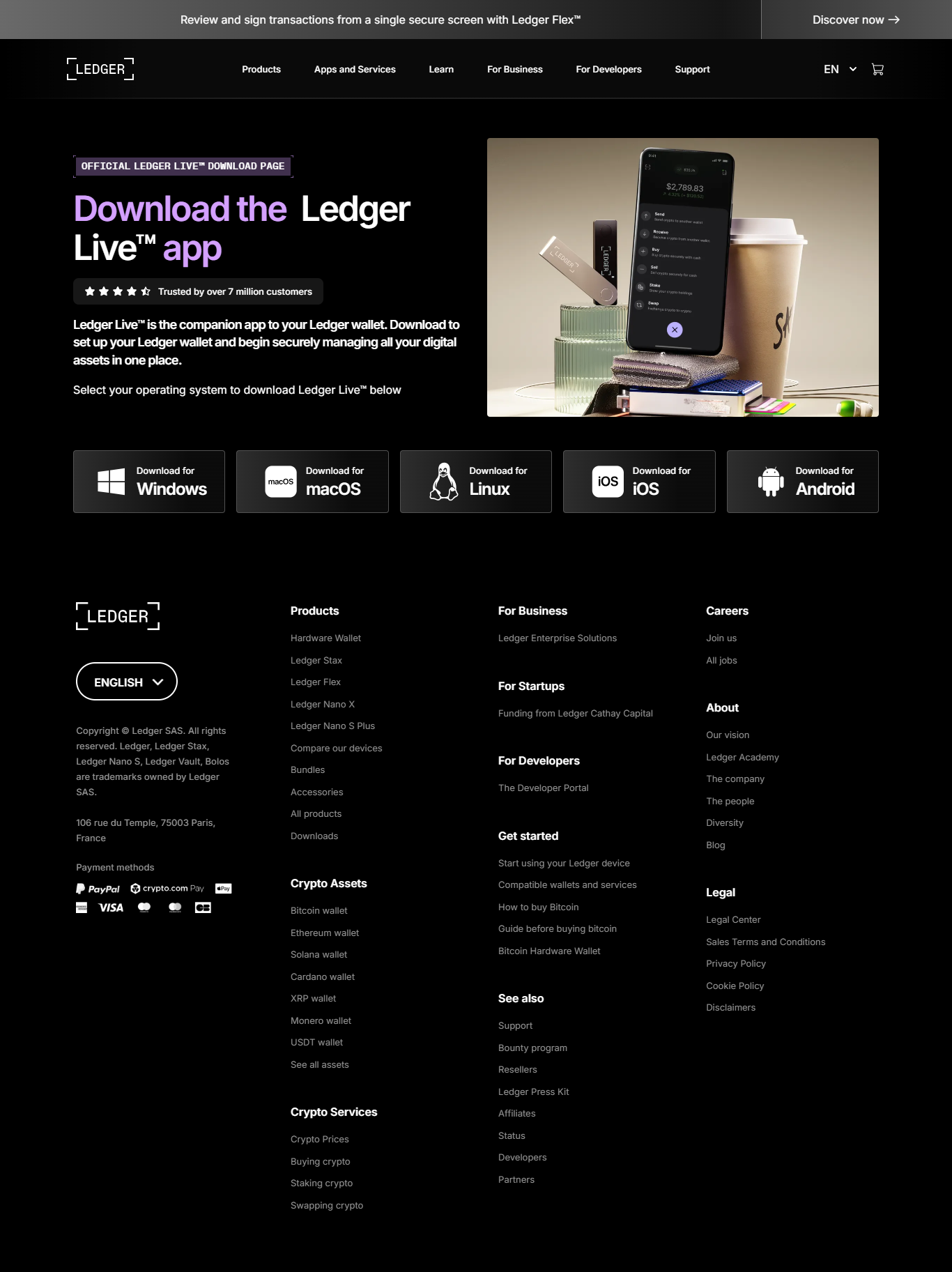Why use Ledger Live?
Ledger Live is designed around one core principle: your private keys never leave your hardware wallet. The app functions as an interface — it reads blockchain balances, prepares transactions, and requests signatures from the Ledger device. This separation means even if a computer or phone is compromised, attackers cannot sign transactions without the physical device and its PIN.
- Security-first: Approvals are always confirmed on-device.
- Wide support: Manage thousands of coins and tokens across multiple blockchains.
- Convenience: Buy, swap, stake, and track your portfolio from a single app.
Download Ledger Live — start safely
Begin every setup by downloading Ledger Live from the official start page: Ledger.com/Start. Avoid third-party download links, attachments, or APKs. Official installers are provided for Windows, macOS, and Linux, and Ledger Live is available in the Apple App Store and Google Play for mobile.
Tip: Verify the publisher is Ledger SAS in app stores and bookmark the official start page to avoid phishing.
Install and launch Ledger Live
- Download the installer or open the mobile app from official sources.
- Run the installer and grant permissions as needed; on first launch follow the onboarding wizard.
- Decide whether you are setting up a new device or restoring from an existing recovery phrase.
- Adjust privacy and analytics preferences during onboarding, and enable an app password or biometric lock for local protection if desired.
Ledger Live does not store your recovery phrase — it only displays blockchain data and manages device interactions locally.
Initialize a new Ledger device
- Connect the Ledger device to your computer using the supplied USB cable (or use Bluetooth for Nano X when pairing mobile).
- On the device, choose Set up as new device and create a secure PIN directly on the hardware.
- The device will generate a 24-word recovery phrase — write this down on the official recovery sheet in order.
- Confirm several words on the device when prompted to ensure you recorded them correctly.
Warning: Never photograph, type, or store your recovery phrase digitally. Anyone with those words can access your funds.
Genuine Check & firmware updates
After initial setup, open Ledger Live → Manager and run the Genuine Check to verify the device authenticity. If Ledger Live prompts a firmware update, follow the instructions and confirm every step on the device screen. Firmware updates include important security patches and new features.
Tip: Use the original cable and avoid USB hubs for firmware updates; keep the device unlocked and connected until complete.
Install coin apps & add accounts
Ledger devices use small blockchain-specific "apps" to interact with each network. In Ledger Live:
- Open Manager and install the apps for the blockchains you plan to use (e.g., Bitcoin, Ethereum, Solana).
- Go to Accounts → Add account, select a currency, and open the corresponding app on your Ledger device when prompted.
- Ledger Live will scan the blockchain and display your addresses, balances, and transaction history.
You can add multiple accounts for the same asset (for example, multiple Ethereum accounts) and rename them for clarity.
Send & receive — verify on-device every time
All transactions require explicit on-device confirmation:
- Receive: Click Receive in Ledger Live, connect and unlock your device, then verify the receiving address displayed on the device before sharing it.
- Send: Click Send, enter recipient and amount, then confirm the exact address, amount, and fee displayed on your Ledger device before approving.
Warning: Trust only what appears on the Ledger device screen — clipboard or UI malware can alter addresses in software.
Ledger Live services — buy, swap, stake
Ledger Live integrates optional third-party services so you can perform more than transfers:
- Buy crypto: Purchase with fiat using trusted partners (availability depends on region and regulations).
- Swap tokens: Exchange assets directly in-app; swaps still require on-device confirmation.
- Stake & earn: Stake supported assets like ETH, DOT, ATOM, and monitor rewards in Ledger Live.
These services are optional — using them does not expose your private keys, which remain on the Ledger device.
Advanced options & privacy
Advanced users can enable passphrase-protected wallets (adds a secret passphrase to create hidden wallets), use coin control for UTXO management, and leverage integrations with dApps and third-party tools. Passphrases add security but also increase responsibility: losing a passphrase means losing access to that hidden wallet.
Troubleshooting common issues
- Device not detected: Try another USB cable or port, avoid USB hubs, ensure Ledger Live is updated, and restart both the device and computer.
- Bluetooth pairing fails (Nano X): Forget the device in your phone’s Bluetooth settings and re-pair through Ledger Live; keep devices close.
- Firmware update stuck: Use the original cable, keep the device unlocked during updates, and retry via Manager.
- Forgot Ledger Live password: Reset the app and reconnect your device; your funds remain safe as keys are on-device and recoverable with the seed.
Lost device & recovery
If your Ledger device is lost, stolen, or damaged, you can restore your wallets on a new Ledger or compatible device using your 24-word recovery phrase. During setup on the new device choose “Restore from recovery phrase” and enter the words in order. If your recovery phrase is lost or compromised, funds may be unrecoverable — protect the phrase in secure, offline storage (consider metal backups for durability).
Security checklist — before every session
- Download Ledger Live only from Ledger.com/Start or official app stores.
- Never enter or share your 24-word recovery phrase — Ledger Support will never ask for it.
- Verify all addresses and amounts on the Ledger device screen before approving.
- Keep Ledger Live, device firmware, and your OS up to date.
- Store recovery phrases offline and consider a fire- and water-resistant backup.
